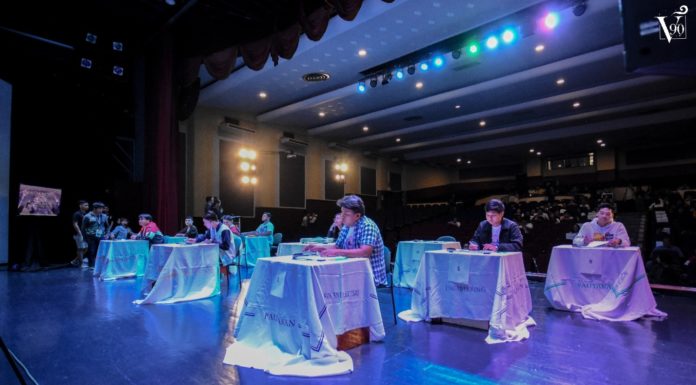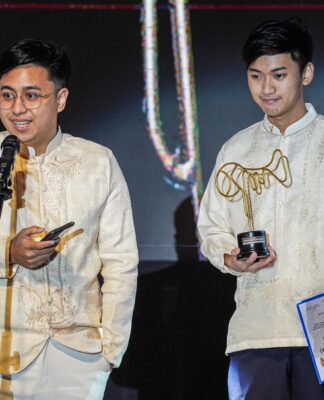A “SMART” cane that optimizes rehabilitation, nanoparticles that detect harmful compounds in food and a crucial discovery that could lead to the reclassification of four plant species—these are some of the best theses produced for academic year 2012-2013.
And did you know that playing boxing on Wii is indeed a good exercise? That’s the finding of a group of Rehabilitation Science students, who joined those from the College of Science and the Faculty of Engineering in conducting some of the most interesting researches on campus.
A group of biology students discovered the real generic identities of Canthium—an endemic species of flowering plant that comes in the form of shrubs and small trees—that should be bound for reclassification.
In the study titled “Contributing to the Philippines’ Biodiversity: Two additional genera from further collapse of the Genus Canthium Lam. (Vanguerieae–Rubiaceae) inferred from Nuclear and Plastid DNA sequence data,” Carizza Marie Magdaleno, Joseph Alvin Pacia, Kim Karlo Quiogue, Annie Eliza Wong and Krysten Marie Yayen from the College of Science sought to determine whether the four plant species, namely, C. gynocthodes, C. oblongifolium, C. obovatofolium and C. oligophlebium should still be included in the genus because they no longer exhibit the presence of supra-axillary spines.
Results based on the Deoxyribonucleic acid sequence of the plants showed that species C. oblongifolium, C. obovatofolium and C. oligophlebium should be classified under genus Pyrostria, while C. gynocthodes must be under genus Psydrax.
“The data generated by this study bridged the gap of the much-needed information on the Systematics of Rubiaceae as a whole and consequently on the Philippines’ biodiversity,” Wong said.
The study can also heighten awareness and give way to improve policy-making in conserving the Philippine flora, specifically threatened and endangered species like Psydrax and Pyrostria.
“The study contributes to the ever-growing biodiversity of the Philippine flora, maintaining the nation’s status as one of world’s 25 recognized biodiversity hot spots and seventh in terms of species endemism and biodiversity,” Wong added.
Food safety
In a separate study titled “Colorimetric detection of Melamine based on green-synthesized silver nanoparticles,” Chemistry student Judee Anne Enriquez used the nanoparticles to confirm whether melamine is present or not in food products.
Melamine is an organic compound with high nitrogen content, making food products appear to be “protein-rich.”
Enriquez noted that it is important to detect the existence of melamine because of its adverse effects on human health, specifically it might result in kidney failure.
“Determining the presence of melamine is very important because the human body can only tolerate a very minimal amount of melamine. If it exceeds, it could even lead to death,” said Enrique, adding that the use of silver mixture is an environment-friendly and cost-efficient way of detecting the dangerous component.
Alternative exercise
Trying to find new forms of exercise, Rehabilitation Sciences students Jose Leandro Manuel Amarado, Jose Enrique Camahort, Anne Kelly Catalan, Bernard Joseph Pacis, Mira Sheera Romero and Katherine Anne Soriano measured the immediate cardiovascular response and body fluid levels of test subjects playing boxing in Nintendo Wii, a movement-based gaming console.
The study, which also won as best research in Physical Therapy named “Acute cardiovascular response and change in hydration status of sedentary young adults aged 18 to 25 years old in playing Wii boxing,” seeks to prevent a sedentary lifestyle in order to maintain an optimal health.
Results of the study showed that playing Wii Boxing for at least 30 minutes per day as an alternative way of physical activity is already a good exercise for the body. It can also improve heart activity.
“As physical therapists, we work to maximize the function of every human being and to improve quality of living in terms of the physical functions of the human body,” Pacis said.
The growing popularity of Wii as a way of exercising in physical rehabilitation clinics led the group to choose the game console as an alternative form of exercise, Pacis added.
“It was the best choice for our study, especially if we are promoting more alternatives for exercise and preventing the growing number of sedentary individuals,” he said.
Engineered to improve
Aiding the field of human rehabilitation, four Electronics Engineering students designed a “smart” cane that aims to optimize the rehabilitation of patients with injured limbs by determining whether appropriate weight is applied on the cane.
Gemmilyn Chu, Erika Jane Imperial, Kelvin George Monje and Rae Mart Pabustan, in their study “Smart Cane: Instrumentation of a Quad Cane with Audio-feedback Monitoring System for partial weight bearing support,” used microcontroller and a small computer to read the force detected by the sensor attached to the cane.
Monje said the data will help maximize the rehabilitation process as it triggers the microcontroller to alarm when the force exerted on the cane is out of the prescribed range of 20 to 25 percent of the patient’s body weight.
A high-pitched alarm will sound from the cane if the exerted force is above the prescribed range and a low-pitched tone will be heard if the weight is below the range.
“If the exerted force always exceeds the prescribed range, it means the patient is becoming more dependent on the cane. This is not good because it will defeat the purpose of rehabilitation, which is to make the patient walk again without the help of these walking aids,” Monje said
The smart cane also allows real-time graphing of the forces exerted on the cane, which will help physical therapists assess the development of the patient since the graphs reflect the development of the patient’s performance.
Meanwhile, Chemical Engineering students Serjan Abalos, Sarah Alyssa Cruz and Angelica Francisco focused their study on how to improve the texture of yogurt and shorten its incubation time by increasing its treatment temperature and adding whey protein isolate, a dietary supplement produced through filtration of milk protein.
In their research titled “Physico-chemical analyses of yogurt made from skimmed and heat-treated carabao’s milk with adjusted whey protein-to-casein ratio,” Abalos said the addition of whey protein gives the yogurt not only a good texture but also a high nutritional value.
The study will also help local suppliers of dairy products in enhancing the production of yogurt.
“By using this technology, they can produce yogurt which has excellent textural and nutritional properties and longer shelf life at a faster rate,” Abalos said.
The study bagged the first place in the 2013 Philippine Institute of Chemical Engineers National Student Research Contest held at Bicol University last Feb. 20.













